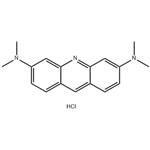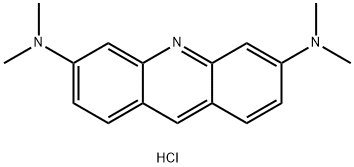- ACRIDINE ORANGE
-

- $5.00 / 1KG
-
2024-03-26
- CAS:65-61-2
- Min. Order: 1KG
- Purity: 98%
- Supply Ability: g-kg-tons, free sample is available
|
| | ACRIDINE ORANGE Basic information |
| Product Name: | ACRIDINE ORANGE | | Synonyms: | 3,6-BIS(DIMETHYLAMINO)ACRIDINE HYDROCHLORIDE;ACRIDINE ORANGE (E GURR);ACRIDINE ORANGE HYDROCHLORIDE;ACRIDINE ORANGE N;BASIC ORANGE;BIS(DIMETHYLAMINO) ACRIDINE HYDROCHLORIDE;AO;CI NO 46005 | | CAS: | 65-61-2 | | MF: | C17H20ClN3 | | MW: | 301.82 | | EINECS: | 200-614-0 | | Product Categories: | Acridine;intermediate | | Mol File: | 65-61-2.mol |  |
| | ACRIDINE ORANGE Chemical Properties |
| Melting point | 284-287 °C(lit.) | | density | 1.001 g/mL at 20 °C | | refractive index | n20/D 1.338 | | storage temp. | -20°C | | solubility | Soluble in water, ethanol, dimethyl sulfoxide | | form | Powder | | pka | -3.2, 10.5(at 25℃) | | Colour Index | 46005 | | color | orange to red | | Water Solubility | H2O: 0.1%, clear, orange to red | | ε(extinction coefficient) | ≥14,000 at 227-233nm in water at 0.005g/L
≥35000 at 265-271nm in water at 0.005g/L | | λmax | 500 nm | | BRN | 3734978 | | Major Application | Adhesives; aluminophosphate crystalline materials; detecting clay particles; display device; evaluating fiber surface characteristics; glass matrixes; imaging material; inks; lasers; recording materials; photoresists; textiles; thin films; tracers for hydrology; wiring boards | | Biological Applications | Detecting cancer cells,spores,human papilloma virus (HPV),stress biomarkers; treating amyloid associated diseases,lupus,pathogen infections; apoptosis assays; cytotoxicity assays | | CAS DataBase Reference | 65-61-2 | | EPA Substance Registry System | C.I. Basic Orange 14 (65-61-2) |
| Safety Statements | 22-24/25 | | WGK Germany | 3 | | RTECS | AR7601000 | | HS Code | 32041300 | | Toxicity | dnd-mus:ast 20 mmol/L BBACAQ 374,96,74 |
| | ACRIDINE ORANGE Usage And Synthesis |
| Chemical Properties | dark orange to brown powder | | Uses | Acridine orange is a dye that interacts with DNA and RNA by intercelation or electrostatic attraction. This cationic dye has been used as a fluorescent stain for nucleic acids in agarose and polyacrylamide gels. | | Preparation | 4,4 ‘-Bis (N, N-dimethyl) aminodiphenylmethane obtained dinitration of 4,4′ – bis (N, N-dimethyl) amino-2 ‘- dinitro-diphenyl methane reduction, and with an acid of heat, so that the diamino compound is cyclized product is oxidized and then cyclized and converted into zinc chloride double salt. | | Biological Activity | acridine orange hydrochloride is a cell and organelle membrane permeable fluorescent dye that targets nucleic acids. acridine orange can either be incorporated into double helical nucleic acids (detected by green fluorescence at 530 nm), or bind electrostatically to phosphate groups of single-stranded molecules (detected by red fluorescence at 640 nm), which renders it the ability to differently stain dna and rna or single-stranded dna in situ. for unfixed cells, acridine orange staining can still be used as a simple, fast approach of obtaining information on cell cycle status and cell ploidy levels from dna staining (green fluorescence), as well as cell transcriptional activity from rna measurements (red fluorescence), in a flow cytofluorometric system. thus, acridine orange may serve as a useful cytochemical stain for cell-cycle and apoptosis studies.1. mcmaster gk, carmichael gg. analysis of single- and double-stranded nucleic acids on polyacrylamide and agarose gels by using glyoxal and acridine orange. proceedings of the national academy of sciences of the united states of america, 1977, 74(11): 4835-4838.2. traganos f, darzynkiewicz z, sharpless t, et al. simultaneous staining of ribonucleic and deoxyribonucleic acids in unfixed cells using acridine orange in a flow cytofluorometric system. journal of histochemistry and cytochemistry, 1977, 25(1): 46-56. | | Safety Profile | Mutation data reported. Whenheated to decomposition it emits very toxic fumes of HCl,Cl??, and NOx. | | Enzyme inhibitor | This cell-permeable dye (FWfree-base = 265.36 g/mol; CAS 65-61-2), also known as N,N,N',N'-tetramethylacridine-3,6-diamine, is an intercalator that binds tightly to nucleic acids. Binding to DNA is characterized by excitation maximum at 502 nm (cyan) and an emission maximum at 525 nm, producing a green fluorescence. (A 120 μM solution of acridine orange will detect 25-50 ng DNA per band in an agarose or polyacrylamide gel.) Binding to RNA is characterized by an excitation maximum at 460 nm and the emission maximum is located at 650 nm, yielding a reddish-orange fluorescence. Acridine orange also penetrates acidic compartments (e.g., lysosomes and phagolysosomes); upon protonation, the dye emits orange light when excited by blue light. | | storage | Room temperature | | Properties and Applications | bright yellow orange. Soluble in water and ethanol for orange yellow, with green fluorescent. The strong sulfuric acid in nearly colorless, a green fluorescent, diluted for orange. The dye solution with strong sodium hydroxide solution have yellow precipitation. And C.I. Solvent Orange 15 the same chemical structure (free base).
|
Standard( Silk )
|
Light Fastness
|
Persperation Fastness
|
Ironing Fastness
|
Soaping
|
|
Fading
|
Stain
|
Fading
|
Stain
|
Fading
|
Stain
|
|
ISO
|
1-2
|
3
|
1
|
5
|
|
1
|
3
|
|
| | ACRIDINE ORANGE Preparation Products And Raw materials |
|